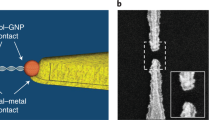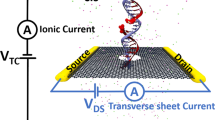Abstract
The function of DNA during oxidative stress1 and its suitability as a potential building block for molecular devices2,3,4 depend on long-distance transfer of electrons and holes through the molecule, yet many conflicting measurements of the efficiency of this process have been reported5,6. It is accepted that charges are transported over long distances through a multistep hopping reaction7,8,9,10,11; this ‘G-hopping’8 involves positive charges moving between guanines (Gs), the DNA bases with the lowest ionization potential. But the mechanism fails to explain the persistence of efficient charge transfer when the guanine sites are distant7,12, where transfer rates do not, as expected, decrease rapidly with transfer distance. Here we show experimentally that the rate of charge transfer between two guanine bases decreases with increasing separation only if the guanines are separated by no more than three base pairs; if more bridging base pairs are present, the transfer rates exhibit only a weak distance dependence. We attribute this distinct change in the distance dependence of the rate of charge transfer through DNA to a shift from coherent superexchange charge transfer (tunnelling) at short distances to a process mediated by thermally induced hopping of charges between adenine bases (A-hopping) at long distances. Our results confirm theoretical predictions of this behaviour13,14,15,16,17, emphasizing that seemingly contradictory observations of a strong8,9 as well as a weak7,12 influence of distance on DNA charge transfer are readily explained by a change in the transfer mechanism.
This is a preview of subscription content, access via your institution
Access options
Subscribe to this journal
Receive 51 print issues and online access
$199.00 per year
only $3.90 per issue
Buy this article
- Purchase on Springer Link
- Instant access to full article PDF
Prices may be subject to local taxes which are calculated during checkout




Similar content being viewed by others
References
Heller, A. Spiers Memorial Lecture: On the hypothesis of cathodic protection of genes. Faraday Discuss. 116, 1–13 (2000).
Fink, H. W. & Schönenberger, C. Electrical conduction through DNA molecules. Nature 398, 407–410 (1999).
Porath, D., Bezryadin, A., De Vries, S. & Dekker, C. Direct measurement of electrical transport through DNA molecules. Nature 403, 635–638 (2000).
Kasumov, A. Y. et al. Proximity-induced superconductivity in DNA. Science 291, 280–282 (2001).
Lewis, F. D. et al. Distance dependent electron transfer in DNA hairpins. Nature 277, 673–676 (1997).
Murphy, C. J. et al. Long-range photoinduced electron transfer through a DNA helix. Science 262, 1025–1029 (1993).
Schuster, G. B. Long-range charge transfer in DNA: transient structural distortions control the distance dependence. Acc. Chem. Res. 33, 253–260 (2000).
Giese, B. Long-distance charge transport in DNA: the hopping mechanism. Acc. Chem. Res. 33, 631–636 (2000).
Lewis, F. D., Letsinger, R. L. & Wasielewski, M. R. Dynamics of photoinduced charge transfer and hole transport in synthetic DNA hairpins. Acc. Chem. Res. 34, 159–170 (2001).
Jortner, J., Bixon, M., Langenbacher, T. & Michel-Beyerle, M. E. Charge transfer and transport in DNA. Proc. Natl Acad. Sci. USA 95, 12759–12765 (1998).
Berlin, Y. A., Burin, A. L. & Ratner, M. A. Charge hopping in DNA. J. Am. Chem. Soc. 123, 260–268 (2001).
Williams, T. T., Odom, D. T. & Barton, J. K. Variations in DNA. Charge transport with nucleotide composition and sequences. J. Am. Chem. Soc. 122, 9048–9049 (2000).
Felts, A. K., Pollard, W. T. & Friesner, R. A. Multilevel Redfield treatment of bridge-mediated long-range electron transfer: a mechanism for anomalous distance dependence. J. Phys. Chem. 99, 2929–2940 (1995).
Okada, A., Chernyak, V. & Mukamel, S. Solvent reorganisation in long-range electron transfer: density matrix approach. J. Phys. Chem. A 102, 1241–1251 (1998).
Segal, D., Nitzan, A., Davis, W. B., Wasielewski, M. R. & Ratner, M. A. Electron transfer rates in bridged molecular systems. A steady-state analysis of coherent tunneling and thermal transitions. J. Phys. Chem. B 104, 3817–3829 (2000).
Grozema, F. C., Berlin, Y. A. & Siebbeles, L. D. A. Mechanism of charge migration through DNA: molecular wire behavior, single-step tunneling or hopping? J. Am. Chem. Soc. 122, 10903–10909 (2000).
Giese, B. & Spichty, M. Long-distance charge transport through DNA: quantification and extension of the hopping model. ChemPhysChem 1, 195–198 (2000).
Saito, I. et al. Mapping of hot spots for DNA damage by one-electron oxidation: Efficacy of GG doublets and GGG triplets as a trap in long range hole migration. J. Am. Chem. Soc. 120, 12686–12687 (1998).
Giese, B. On the mechanism of long-range electron transfer through DNA. Angew. Chem. Int. Edn Engl. 38, 996–998 (1999).
Steenken, S. & Jovanovic, S. V. How easily oxidizable is DNA? One-electron reduction potentials of adenosine and guanosine radicals in aqueous solution. J. Am. Chem. Soc. 119, 617–618 (1997).
Steenken, S., Jovanovic, S. V., Bietti, M. & Bernhard, K. The trap depth (in DNA) of 8-oxo-7,8-dihydro-2′-deoxyguanosine as derived from electron-transfer equilibria in aqueous solution. J. Am. Chem. Soc. 122, 2373–2374 (2000).
Acknowledgements
We thank M. E. Michel-Beyerle and W. B. Davis for discussions. This work was supported by the Swiss National Science Foundation and the Volkswagen Foundation.
Author information
Authors and Affiliations
Corresponding author
Rights and permissions
About this article
Cite this article
Giese, B., Amaudrut, J., Köhler, AK. et al. Direct observation of hole transfer through DNA by hopping between adenine bases and by tunnelling. Nature 412, 318–320 (2001). https://doi.org/10.1038/35085542
Received:
Accepted:
Issue Date:
DOI: https://doi.org/10.1038/35085542
This article is cited by
-
From molecular to supramolecular electronics
Nature Reviews Materials (2021)
-
Electronic Properties of Short Polynucleotides Studied Using Schottky Junctions
Journal of Electronic Materials (2021)
-
Theoretical modeling of DNA electron hole transport through polypyrimidine sequences: a QM/MM study
Journal of Molecular Modeling (2019)
-
Detection and identification of genetic material via single-molecule conductance
Nature Nanotechnology (2018)
-
Charge splitters and charge transport junctions based on guanine quadruplexes
Nature Nanotechnology (2018)
Comments
By submitting a comment you agree to abide by our Terms and Community Guidelines. If you find something abusive or that does not comply with our terms or guidelines please flag it as inappropriate.



